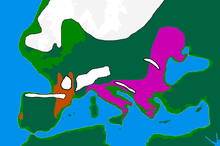Epigravettian
Appearance
 | |
| Alternative names | Tardigravettian |
|---|---|
| Geographical range | Southern and Eastern Europe |
| Period | Late Upper Paleolithic |
| Dates | ~21,000 – 10,000 cal. BP [1] |
| Type site | None (because likely a continuation of the Gravettian) |
| Major sites | Paglicci, Arene Candide, Riparo Tagliente, Dolní Věstonice |
| Preceded by | Gravettian |
| Followed by | Mesolithic cultures |
| Defined by | Georges Laplace, 1958 (broader-than-modern meaning)[2] Broglio, Laplace et al., 1963 (modern meaning, as “Tardigravettiano”)[3] |
The Epigravettian (Greek: epi "above, on top of", and Gravettian) was one of the last archaeological industries of the European Upper Paleolithic. It arose after the Last Glacial Maximum around ~21,000 cal. BP. It is related to the Gravettian, of which it is considered a continuation by some scholars (e.g. G. Laplace). In this sense, the Epigravettian is simply the Gravettian after ~21,000 BP,[is this date calibrated?] when the Solutrean had replaced the Gravettian in most of France and Spain.
Its known range extends from southeast France to the western shores of the Volga River, Russia, with a large number of sites in Italy. It was replaced by Mesolithic cultures around 10,000 BP.
References
- ^ Montoya, Cyril (2004). Les traditions techniques lithiques à l’Épigravettien: Analyses de séries du Tardiglaciaire entre Alpes et Méditerranée (Ph.D.) (in French). Université de Provence. p. 5.
- ^ Template:Cite article
- ^ Template:Cite article
Categories:
- Upper Paleolithic cultures of Europe
- Archaeological cultures of Eastern Europe
- Archaeological cultures of Southeastern Europe
- Archaeological cultures of Southern Europe
- Archaeological cultures in Austria
- Archaeological cultures in Croatia
- Archaeological cultures in Italy
- Archaeological cultures in Montenegro
- Archaeological cultures in Romania
- Archaeological cultures in Serbia
- Archaeological cultures in Slovakia
- Archaeological cultures in Ukraine
- Stone Age Austria
- Archaeology stubs
